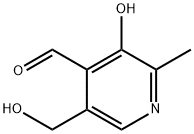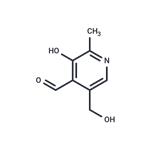Definition
ChEBI: A pyridinecarbaldehyde that is pyridine-5-carbaldehyde bearing methyl, hydroxy and hydroxymethyl substituents at positions 2, 3 and 4 respectively.
Enzyme inhibitor
This photosensitive aldehyde form of vitamin B6 (FW = 167.16 g/mol), systematically referred to as 3-hydroxy-5-(hydroxymethyl)-2-methyl-4- pyridinecarboxaldehyde, is the immediate precursor to the coenzyme pyridoxal 5’-phosphate (PLP) and is often a weaker competitive inhibitor of PLP binding to PLP-dependent enzymes). Pyridoxal is soluble in water (1 g/2 mL) and sensitive to heat, particularly at alkaline pH. The pKa values are 4.23 (phenol OH), 8.70 (pyridinium NH+), and 13.0. Pyridoxal has a lmax value of 252 nm at pH 7.0 (e = 8200 M–1cm–1). It is typically supplied as the hydrochloride. Target(s): O-acetylhomoserine aminocarboxypropyltransferase, or O-acetylhomoserine (thiol)-lyase; alanine racemase; aldehyde dehydrogenase; arginine decarboxylase; cystathionine b-lyase, or cystine lyase; cysteine synthase; dextransucrase; b-fructofuranosidase, or invertase; glutamate dehydrogenase; hemoglobin S polymerization; hydroxyacyl-glutathione hydrolase, or glyoxalase II; kynurenine 3- monooxygenase; lactoylglutathione lyase, or glyoxalase I; NMN nucleosidase; phosphopantothenoylcysteine decarboxylase; porphobilinogen synthase, or d-aminolevulinate dehydratase; pyridoxal kinase; pyridoxal phosphatase, weakly inhibited; starch phosphorylase; thiamin phosphatase; tyrosinase; and xanthine dehydrogenase.

